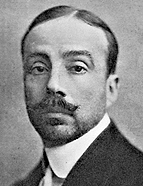

José de Figueiredo was born in Porto on 20 December 1871. He was the youngest of three brothers, the sons of Leopoldina Cândida Albernaz Nunes de Carvalho (born in Lisbon, died in 1917) and Agostinho José de Figueiredo (born in Vouzela, died in 1875), a wholesale trader who made his fortune in Brazil.
He learnt his first letters at the Colégio de São Carlos [São Carlos College] in Porto. In 1888 he entered the University of Coimbra and graduated in law on 25 July 1893. He then returned to his hometown, where he worked in a notary's office. However, his lack of interest in his professional life and the illness of his brother Agostinho, who had meanwhile been hospitalised in Paris, led him to leave for the French capital in 1895.
After settling in the City of Light, he explored his taste for artistic subjects, attending free courses in art history, visiting exhibitions, museums, and antique shops, and socialising with Portuguese and foreign scholars, historians and artists. This was when he became a friend of Salomon Reinach (archaeologist, art historian and co-founder of the Louvre School), Émile Bertaux (art historian), Yvanhoé Rambosson (art critic and one of the organisers of the Paris salons in the early 20th century), Georges Demotte (antiques dealer and publisher) and the sculptor Auguste Rodin. The Parisian experience allowed him to develop an ability to analyse and criticise art, which resulted in the publication of his first books in 1901: Portugal na Exposição de Paris [Portugal at the Paris Exhibition] and O Legado Valmor e a Reforma dos Serviços de Bellas-Artes [The Valmor Legacy and the Reform of the Fine Arts Services].
After returning to Portugal, he was appointed 1st officer of the General Directorate of Public Instruction (24 December 1901) and settled in Lisbon. Thanks to his networks, he quickly became a part of the intellectual and cultural life of the capital. During this period, he was appointed a member of the Superior Council of National Monuments (December 1902) and an academician of merit at the Lisbon Academia Real de Belas-Artes [Royal Academy of Fine Arts] (19 December 1903). Within this organisation he developed his first major personal project: the campaign to restore, exhibit and study the St. Vincent Panels, which gave origin to the publication of his major reference work, the monograph Arte portuguesa primitiva. O pintor Nuno Gonçalves [Primitive Portuguese art. The painter Nuno Gonçalves]. José de Figueiredo was 39 years old at the time. The success of this project coincided with a political climate that proved to be highly favourable for his career: the change of regime in October 1910 promoted the implementation of important reform plans in the field of artistic and patrimonial institutions, providing an ideal context for the great role that would give him his public recognition: his appointment as director of the Museu Nacional de Arte Antiga (MNAA) [National Museum of Ancient Art] in 1911.
This work is financed by national funds through FCT - Foundation for Science and Technology, I.P, in the scope of the projects UIDB/04311/2020 and UIDP/04311/2020.
